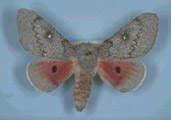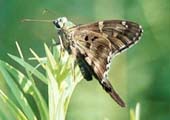Native Plants
Search for native plants by scientific name, common name or family. If you are not sure what you are looking for, try the Combination Search or our Recommended Species lists.
Prosopis glandulosa
Prosopis glandulosa Torr.
Honey Mesquite, Glandular Mesquite, Algarroba
Fabaceae (Pea Family)
Synonym(s):
USDA Symbol: PRGL2
USDA Native Status: L48 (N), HI (I), VI (I)
Honey mesquite is a shrub or small tree to 30 ft. The crown spreads a distance equal or more to the height. Twigs are armed with sharp thorns up to 2 inches long especially on young plants. Twice-compound, deciduous leaves are very bright-green and feathery. Leaflets up to 2 inches long and 3 1/16 inch wide. Tiny, yellow-green, fragrant flowers occur in dense, spike-like racemes appearing in April and as late as August during wet summers. Fruit a long, yellowish brown pod, somewhat flattened and with slight constrictions between the seeds.
The seeds are disseminated by livestock that graze on the sweet pods, and the shrubs have invaded grasslands. Cattlemen regard mesquites as range weeds and eradicate them. In sandy soils, dunes often form around shrubby mesquites, burying them except for a rounded mass of branching tips. The deep taproots, often larger than the trunks, are grubbed up for firewood. Southwestern Indians prepared meal and cakes from the pods. As the common name indicates, this species is also a honey plant. The word "mesquite" is a Spanish adaptation of the Aztec name "mizquitl."
Plant Characteristics
Duration: PerennialHabit: Tree
Leaf Retention: Deciduous
Leaf Arrangement: Alternate
Fruit Type: Legume
Size Notes: Up to about 30 feet tall.
Flower: Flowers 3 inches long
Bloom Information
Bloom Color: YellowBloom Time: Feb , Mar , Apr , May , Jun , Jul , Aug , Sep
Distribution
USA: AZ , CA , CO , KS , LA , NM , NV , OK , TX , UTNative Distribution: LA & OK to s. CA, s. to n. Mex.; includes extreme s.w. UT
Native Habitat: Deserts; plains; stream banks; arroyos
Growing Conditions
Water Use: LowLight Requirement: Sun
Soil Moisture: Dry
Cold Tolerant: yes
Heat Tolerant: yes
Soil Description: Well-drained soils. Sandy, Sandy Loam, Medium Loam Clay Loam, Clay, Caliche type.
Conditions Comments: Mesquite needs deep watering to become a tree, but tolerates drought thereafter. Plants are drought-tolerant when young but will remain shrubs if not irrigated. Bloom period is predominantly spring, but the plant does flower at other times. P. glandulosa, erroneously known also as P. juliflora and P. chilensis, is represented by two varieties: var. glandulosa and var. torreyana. This aggressive plant has increased greatly in abundance (though it has not much extended its geographic range) in the last 120 years, becoming especially abundant on disturbed grasslands.
Benefit
Use Ornamental: Fast growing, Showy, Blooms ornamental, Attractive, Fixes nitrogen, Planned landscape, Shade treeUse Wildlife: An excellent bee tree. Nectar-bees, Nectar-insects, Cover, Fruit-mammals, Fruit-birds.
Use Food: Lining of seedpods separated, dried, and ground into a powder to make mesquite meal or mesquite flour, a sweet-tasting substance that was a staple of the indigenous diet where this and other Prosopis species grew and has been rediscovered today for its nutritive value and caramel-like flavor.
Use Other: Wood used as firewood and notably to impart a smoky flavor to meats in the Southwest, particularly in Texas.
Conspicuous Flowers: yes
Interesting Foliage: yes
Attracts: Butterflies
Larval Host: Long-tailed Skipper Urbanus proteus, Reakirt's Blue Echinargus isola, Heiligbrodt's Mesquite Moth Sphingicampa heiligbrodti
Deer Resistant: Moderate
Value to Beneficial Insects
Special Value to Native BeesSpecial Value to Honey Bees
Provides Nesting Materials/Structure for Native Bees
This information was provided by the Pollinator Program at The Xerces Society for Invertebrate Conservation.
Butterflies and Moths of North America (BAMONA)
|
Heiligbrodt's Mesquite Moth (Sphingicampa heiligbrodti)  Larval Host |
Long-tailed Skipper (Urbanus proteus)  Larval Host |
Propagation
Propagation Material: Root DivisionDescription: Easily grown from fresh, untreated seed or stored, treated seed. Cuttings from young wood will root.
Seed Collection: Gather pods as soon as they turn brown. Dry pods and extract their seed. Seeds can be stored in sealed, refrigerated containers for several years.
Seed Treatment: Stored seed requires hot water or mechanical scarification.
Commercially Avail: yes
Find Seed or Plants
Find seed sources for this species at the Native Seed Network.
Mr. Smarty Plants says
Edible plants native to Austin, TX
August 05, 2009
Hello,
I am a chef from Buenos Aires Argentina visiting Austin, Texas and would like to learn about native, edible plants in the region.
Please let me know if there are any native, edible plants...
view the full question and answer
Are Mesquite (Prosopis) pods safe for dogs to eat?
June 15, 2009
are pods from mesquite trees posionus to dogs if they chew or eat them?
view the full question and answer
Replacing grass with xeric plants in Nevada
March 20, 2009
I am looking to xeriscape my front yard - remove all grass! I am thinking 3-4 larger plants: bird of paradise (mesquite??), aloe, and ..?? Also, possibly a Chilean mesquite.
Do you have suggestio...
view the full question and answer
Name of the rough-barked mimosa (Albizia kalkora)
February 12, 2008
I read two years ago that there was two different mimosa trees one that is common and has the smooth bark and the other one had a rough bark. I am Interested in the one who has the rough bark and the ...
view the full question and answer
National Wetland Indicator Status
| Region: | AGCP | AK | AW | CB | EMP | GP | HI | MW | NCNE | WMVE |
| Status: | UPL | UPL | FAC | UPL | FACU | UPL | UPL |
From the National Organizations Directory
According to the species list provided by Affiliate Organizations, this plant is on display at the following locations:Lady Bird Johnson Wildflower Center - Austin, TX
Brackenridge Field Laboratory - Austin, TX
Nueces River Authority - Uvalde, TX
Texas Parks and Wildlife Department - Austin, TX
Texas Master Naturalists - Lost Pines Chapter - Bastrop, TX
National Butterfly Center - Mission, TX
Native Seed Network - Corvallis, OR
Jacob's Well Natural Area - Wimberley, TX
NPSOT - Williamson County Chapter - Georgetown, TX
Herbarium Specimen(s)
NPSOT 0375 Collected Apr 28, 1987 in Bexar County by Harry CliffeNPSOT 0246 Collected June 23, 1992 in Comal County by Mary Beth White
Bibliography
Bibref 1186 - Field Guide to Moths of Eastern North America (2005) Covell, C.V., Jr.Bibref 298 - Field Guide to Texas Trees (1999) Simpson, B.J.
Bibref 1185 - Field Guide to Western Butterflies (Peterson Field Guides) (1999) Opler, P.A. and A.B. Wright
Bibref 355 - Landscaping with Native Plants of Texas and the Southwest (1991) Miller, G. O.
Bibref 354 - Native & Naturalized Woody Plants of Austin & the Hill Country (1981) Lynch, D.
Bibref 841 - Native Alternatives to Invasive Plants (2006) Burrell, C. C.
Bibref 995 - Native Landscaping from El Paso to L.A. (2000) Wasowski, S. and A. Wasowski
Bibref 318 - Native Texas Plants: Landscaping Region by Region (2002) Wasowski, S. & A. Wasowski
Bibref 291 - Texas Wildscapes: Gardening for Wildlife (1999) Damude, N. & K.C. Bender
Bibref 297 - Trees of Central Texas (1984) Vines, Robert A.
Search More Titles in Bibliography
Additional resources
USDA: Find Prosopis glandulosa in USDA PlantsFNA: Find Prosopis glandulosa in the Flora of North America (if available)
Google: Search Google for Prosopis glandulosa
Metadata
Record Modified: 2015-11-06Research By: TWC Staff